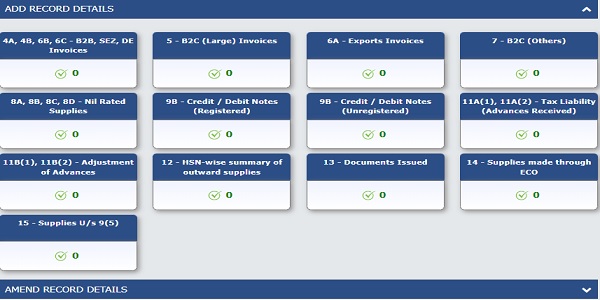Introduction: The Goods and Services Tax Network (GSTN) has recently introduced significant changes in the GSTR-1 return. Commencing from January 2024 month GSTR-1 return, two new tables, namely Table 14 and Table 15, have been incorporated into the GST Portal and it brings a consequential impact on GSTR-3B, specifically on Table 3.1.1. These additions aim to streamline the reporting process for taxable outward supplies made through e-commerce operators and those falling under Section 9(5) of the CGST Act, 2017.
♦ Existing Tables of GSTR-1 return: –
Table 4A to Table 13
♦ New Changes in GSTR-1 : Introduction of Table 14 and 15 in GSTR-1 return starting from January 2024:-
1. Table 14 – Supplies Made Through E-Commerce Operators (ECO):
In this table, the supplier can add details of taxable outward supplies made through e-commerce operator.
Two types of supplies to be reported in this table as follows:
- ‘Liable to collect tax u/s 52 (TCS)’ – By default, this tab shall be displayed. Please report here the summary of Supplies made through E-Commerce Operators – u/s 52 (TCS).
(The supplier has to report details like GSTIN of ECO, Trade/Legal name, Net value of supplies, IGST, CGST, SGST, Cess)
Section 52 of the CGST Act, 2017 mandates e-Commerce Operators (ECO) to collect TCS @ 1% on the net taxable supplies made by other suppliers through their platform, where the consideration in respect of such supplies is collected by e-Commerce Operator.

- ‘Liable to pay tax u/s 9(5)’ – This tab shall be display on table 14, you can add record by click on this tab. Please report here the summary of the Supplies made through E-commerce operators u/s 9(5) where ECO is liable to pay tax u/s 9(5).
(The supplier has to report details like GSTIN of ECO, Trade/Legal name, Net value of supplies, IGST, CGST, SGST, Cess)
Section 9(5) of the CGST Act, 2017 mandates e-Commerce Operators (ECO) to pay output tax under RCM on specified category of services and treat ECO as supplier of the services even though e-commerce operator is not the actual supplier.
List of Specified services u/s 9(5):-
- Passenger transport services
- Housekeeping services
- Restaurant services (Cloud kitchen)
- Accommodation services
2. Table 15 – Supplies u/s 9(5) of the CGST Act:
In this table, the ECO can add details of taxable outward supplies on which the e-commerce operator is liable to pay tax under Section 9(5) of the CGST Act.

The e-commerce operator can report the supplies on which e-commerce operator is liable to pay tax under section 9(5) of the Act for the below types of suppliers and recipients:
- Registered Supplier to Registered Recipient (B2B) :
- Registered Supplier to Unregistered Recipient (B2C)
- Unregistered Supplier to Registered Recipient (URP2B)
- Unregistered Supplier to Unregistered Recipient (URP2C)
3. Impact in GSTR-3B return: –
The integration of Tables 14 and 15 in GSTR-1 brings about a consequential impact on GSTR-3B, specifically on Table 3.1.1.
- In GSTR – 3B, Table 3.1.1 addresses supplies notified under Section 9(5) of the CGST Act, 2017. This table requires suppliers and e-commerce operators (ECOs) to separately report supplies on which the e-commerce operator is liable to pay tax.
- Table 3.1.1 (i) to be furnished by e-commerce operators (ECO) showing taxable supplies on which ECO pays tax u/s 9(5)
- Table 3.1.1 (ii) to be furnished by registered suppliers making supplies through electronic commerce operator on which ECO is required to pay tax u/s 9(5)
Please note that the above supplies should not be included in Table 3.1. (a) of the GSTR-3B. Table 3.1.1 (i) and (ii) are auto-drafted based on values provided in GSTR-1/IFF.
- Previously, GSTR-1 did not have specific tables for reporting these transactions separately. As a result, Table 3.1.1 in GSTR-3B was not auto-filled due to the absence of corresponding reporting sections.
- Starting from January 2024, GSTR-1 has introduced Tables 14 and 15 specifically designed for reporting supplies on which e-commerce operators are liable to pay tax. This modification ensures accurate auto-filling of Table 3.1.1 in GSTR-3B for both suppliers and e-commerce operators.
Conclusion:
The inclusion of Tables 14 and 15 in GSTR-1 marks a progressive step towards enhancing the precision and comprehensiveness of GST filings, particularly for businesses engaged in e-commerce transactions. The modification addresses the challenges faced by suppliers and e-commerce operators in reporting supplies falling under Section 9(5) of the CGST Act, streamlining the entire process and fostering greater compliance with GST regulations. As businesses adapt to these changes, it is crucial to stay abreast of such updates to ensure seamless and accurate GST filings in the evolving tax landscape.
******
DISCLAIMER: This publication is merely a general guide meant for knowledge purposes only. All the references or content are for educational purposes only and do not constitute a legal advice. We do not accept any liabilities whatsoever for any losses caused directly or indirectly by the use/reliance of any information or conclusion contained in this publication. Prior to acting upon this publication, you’re suggested to seek the advice.






PINKY WISH TO TALK FOR FURTHER CLARIFICATION.9414231820